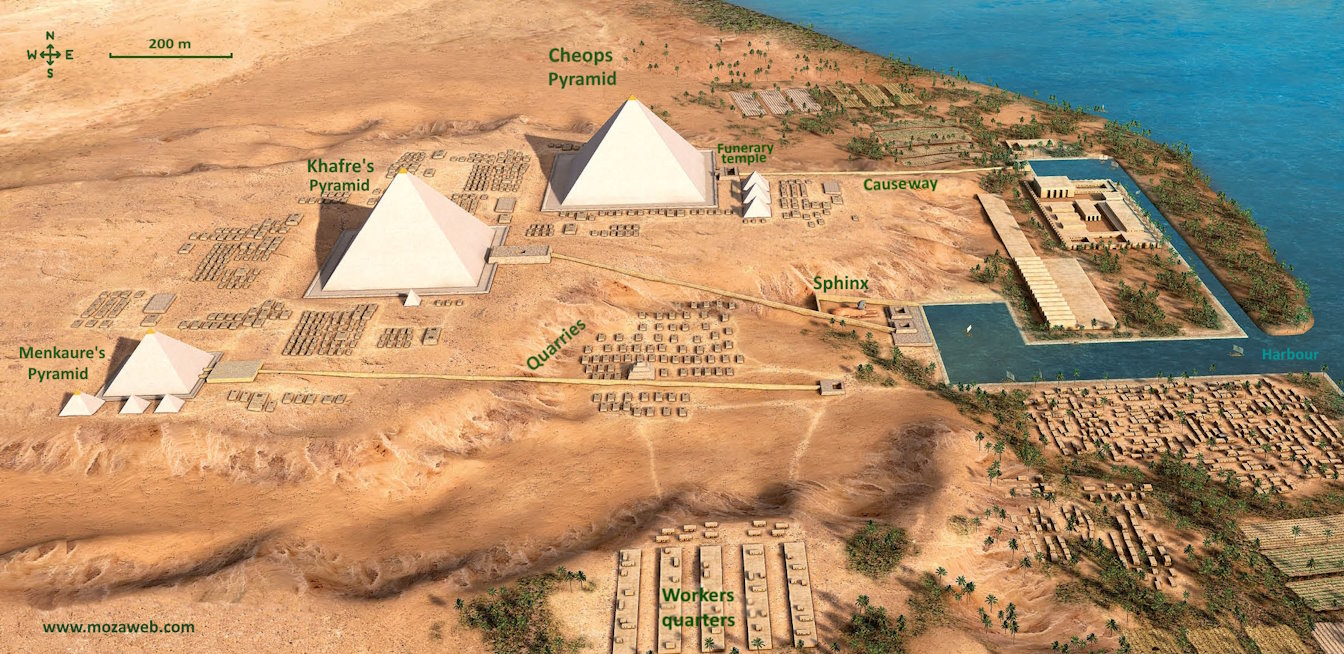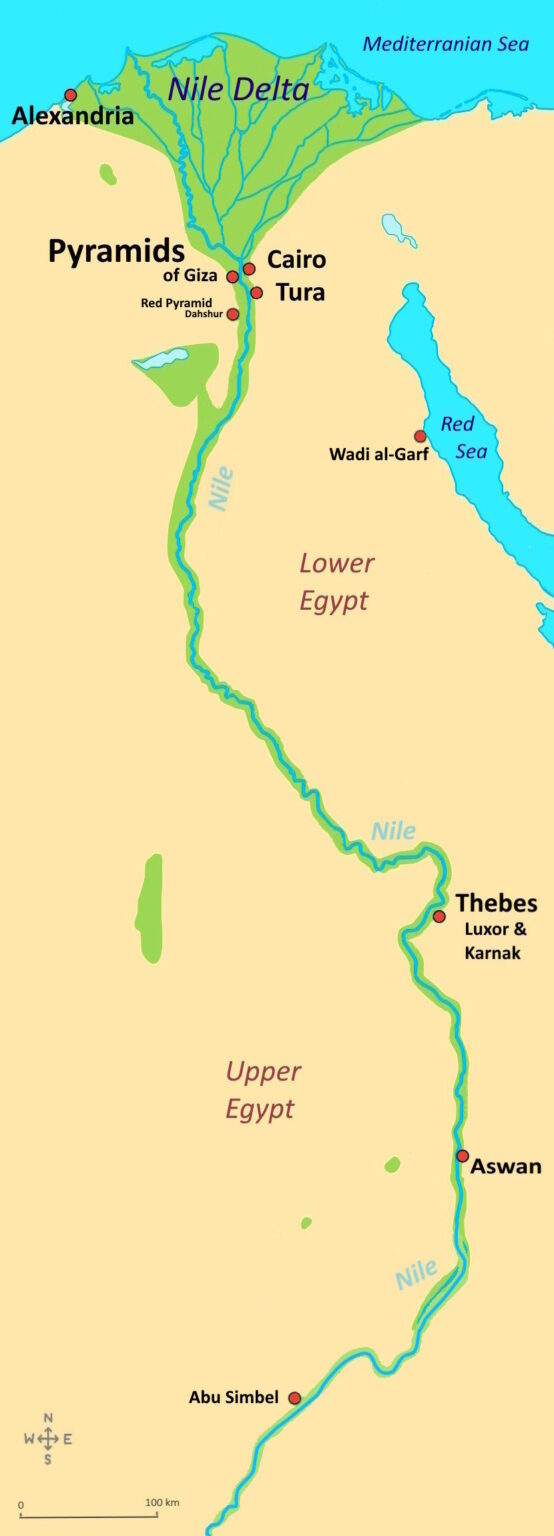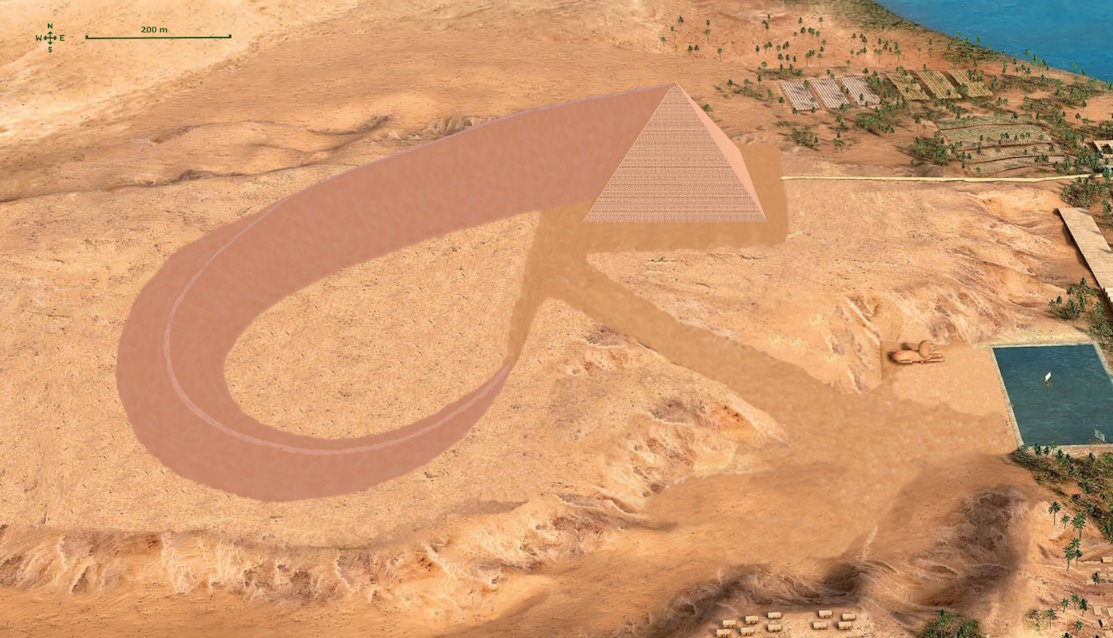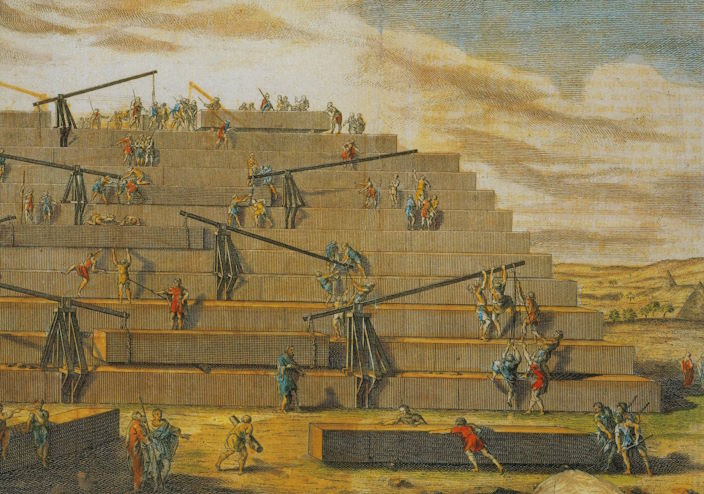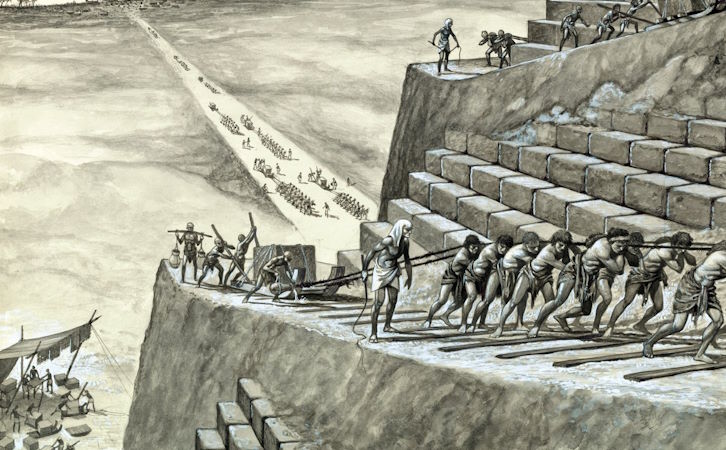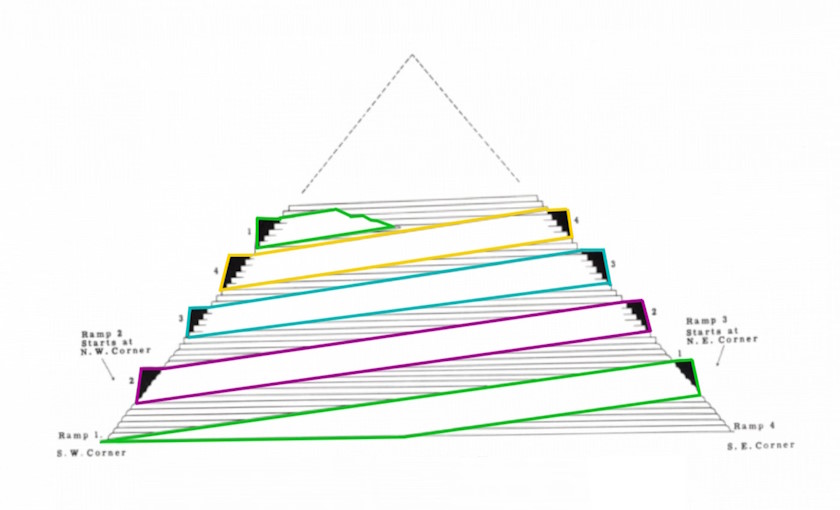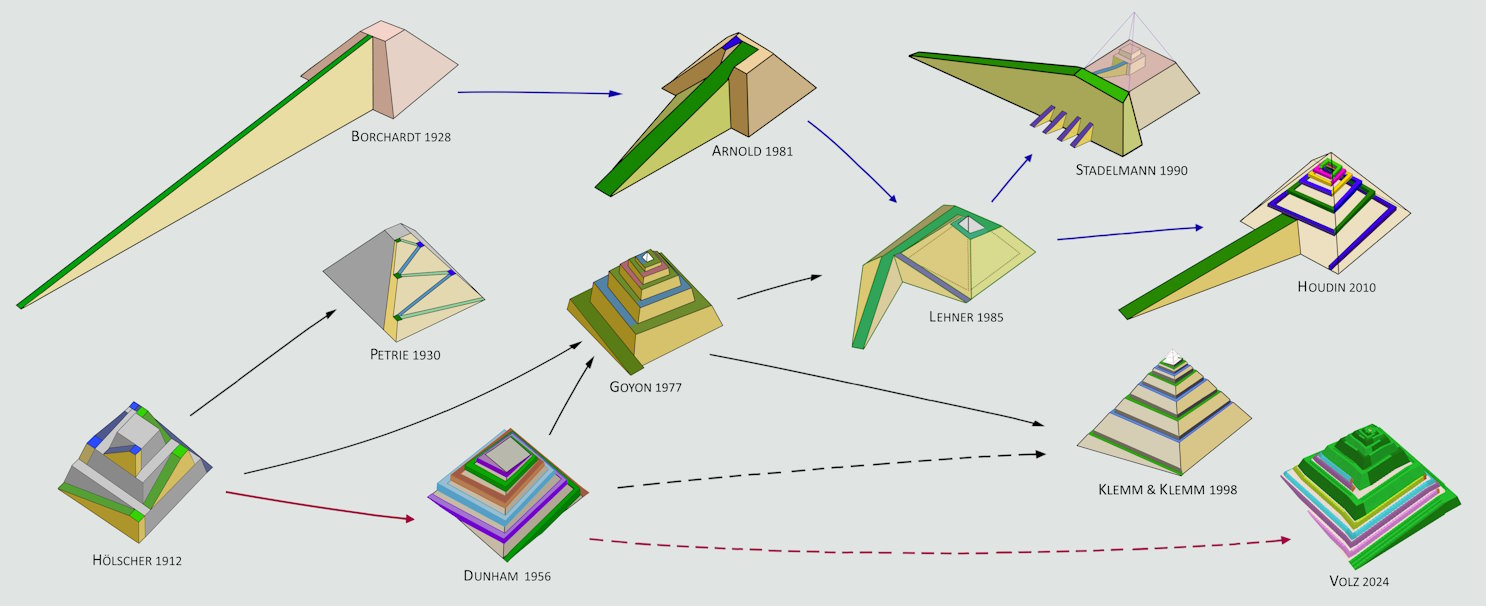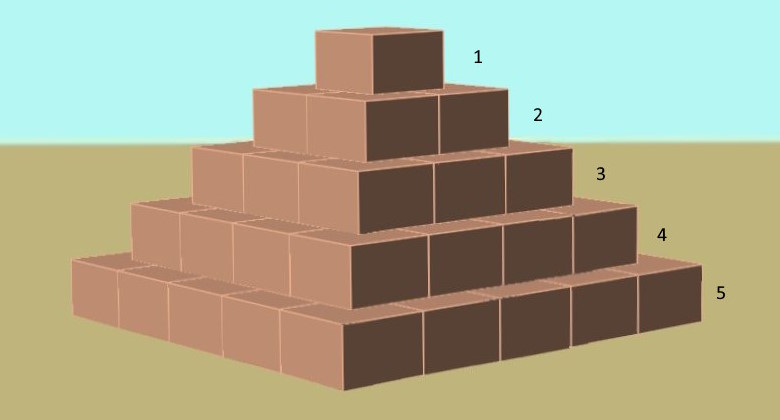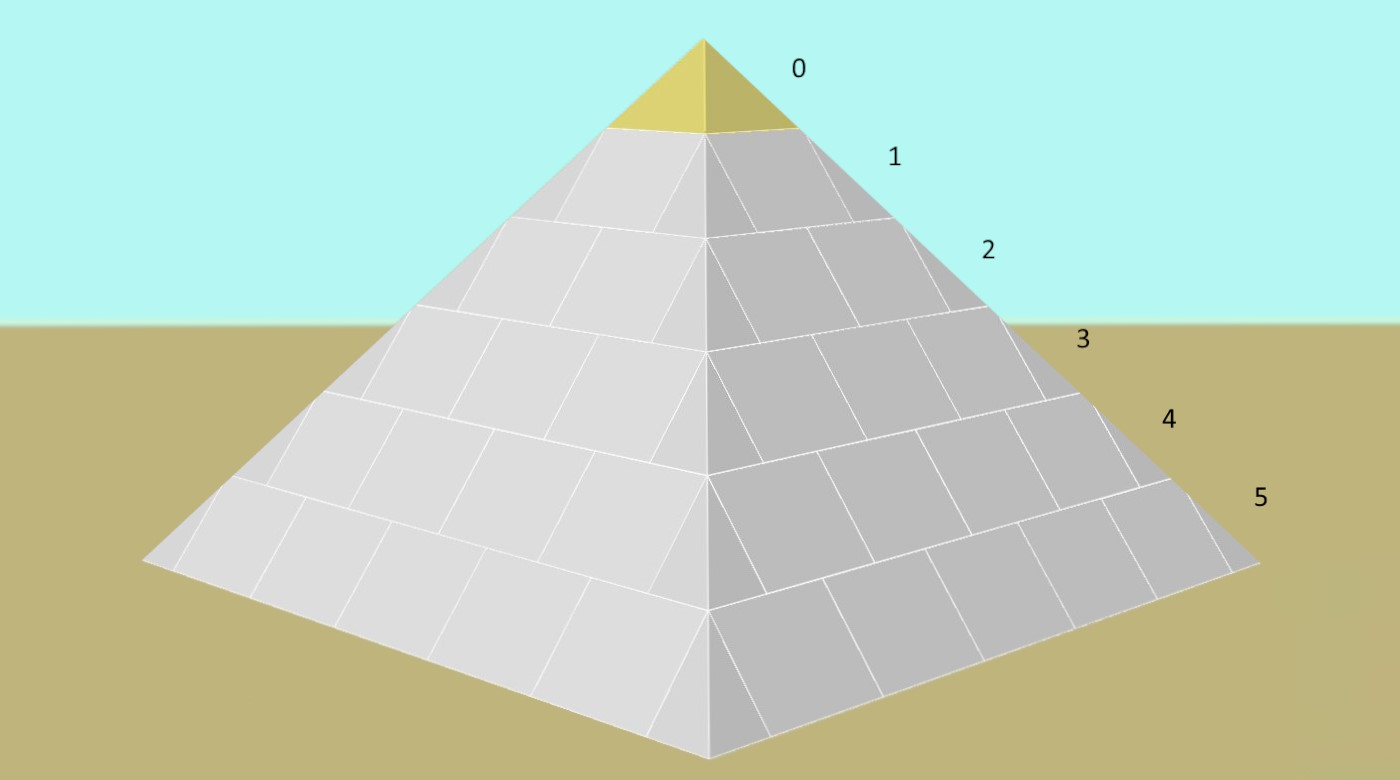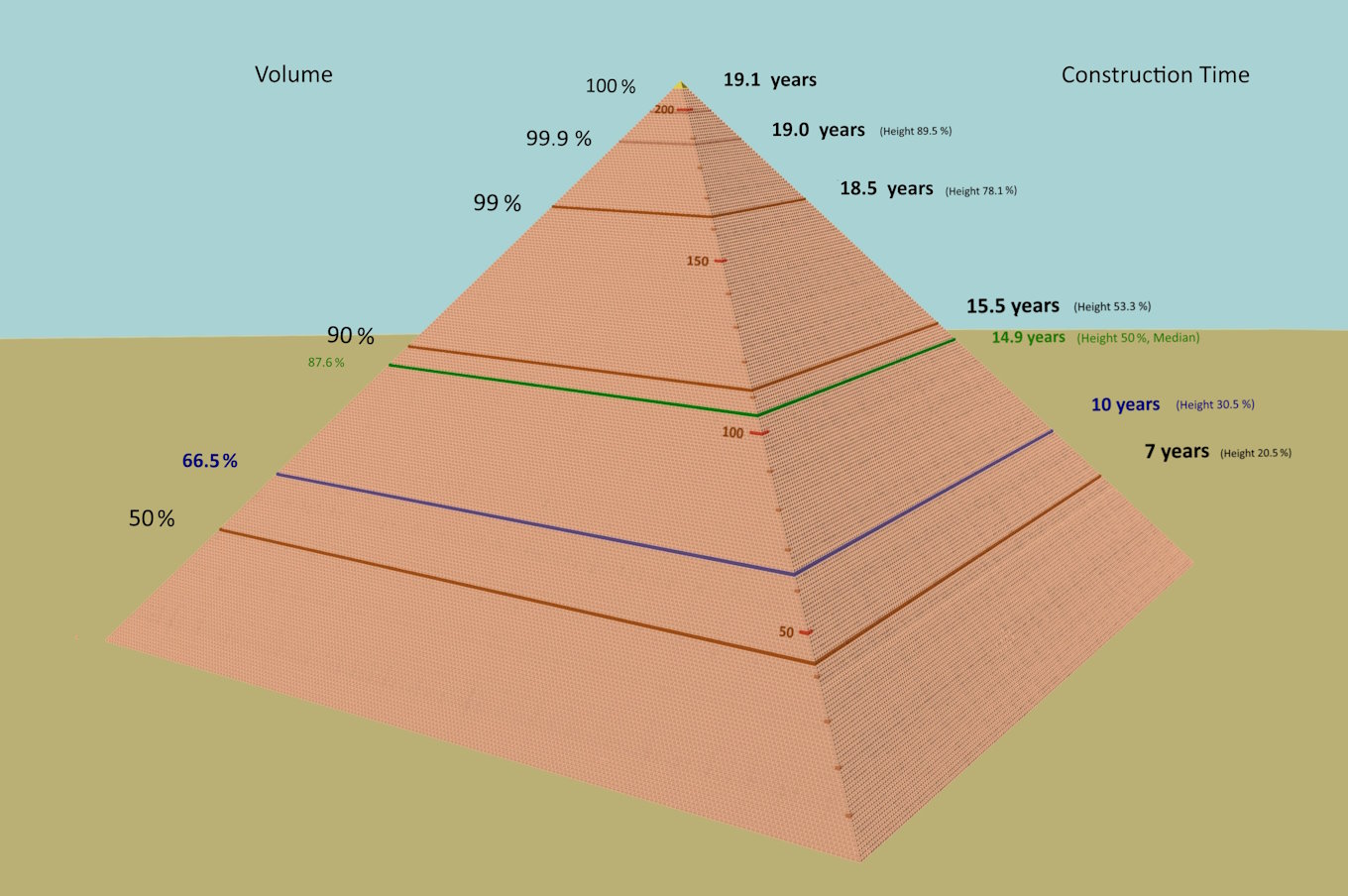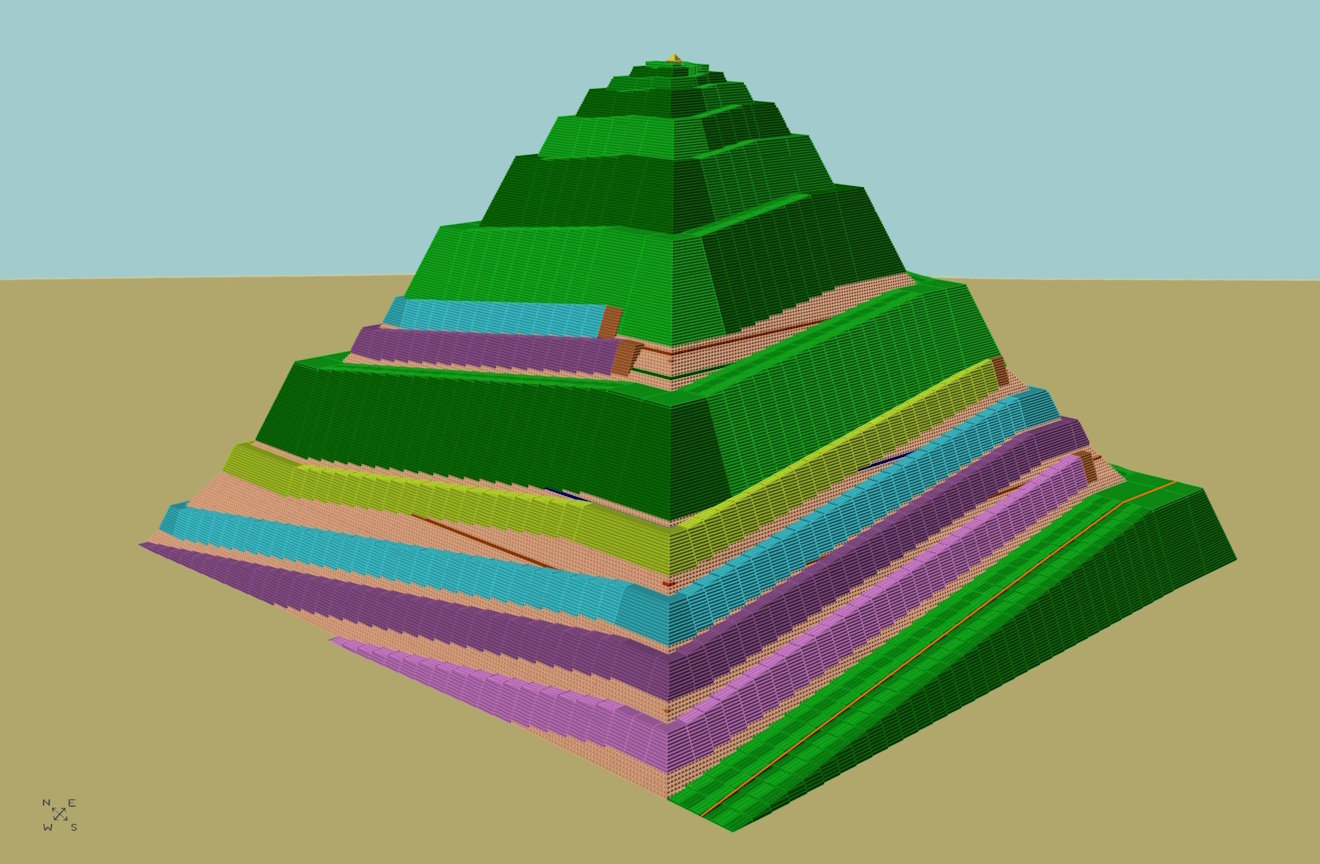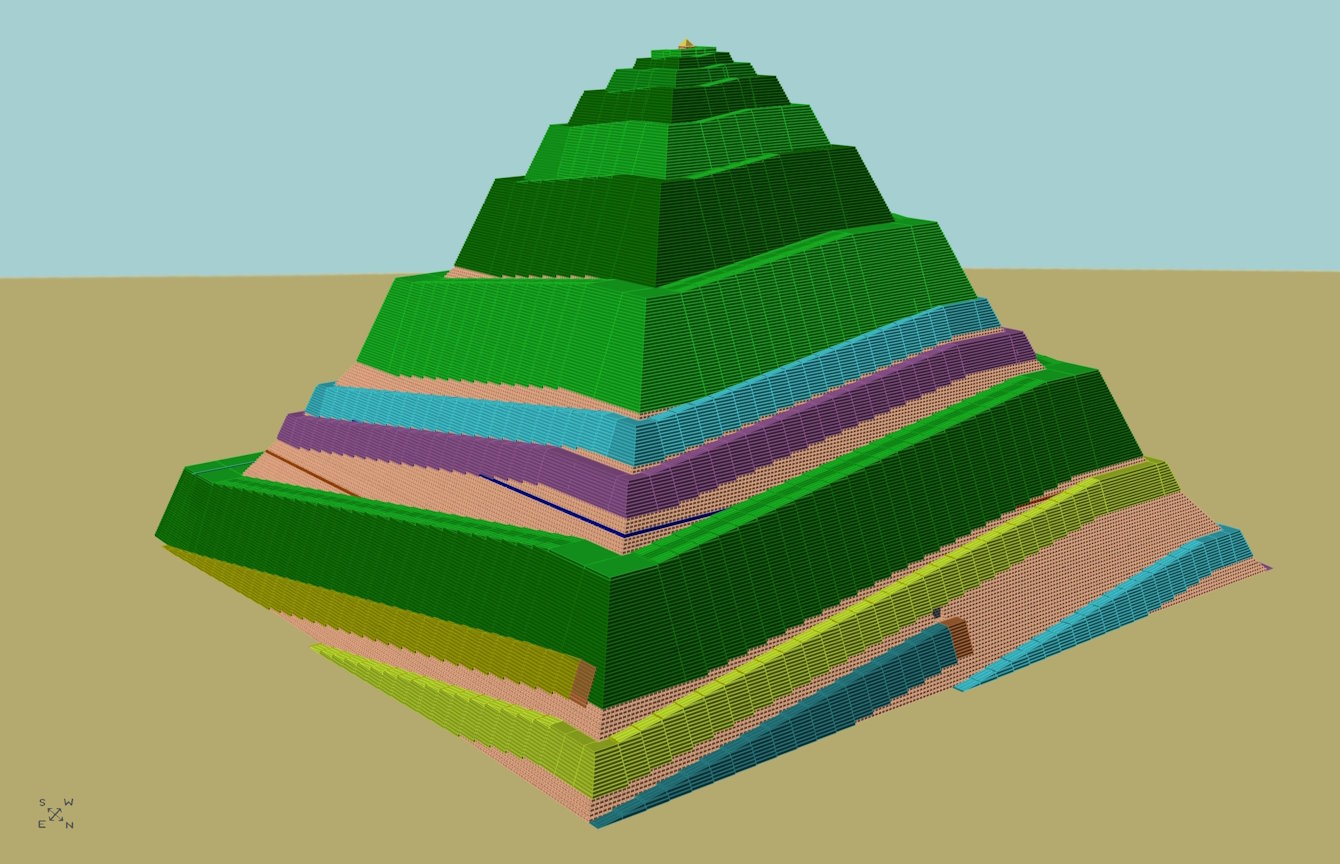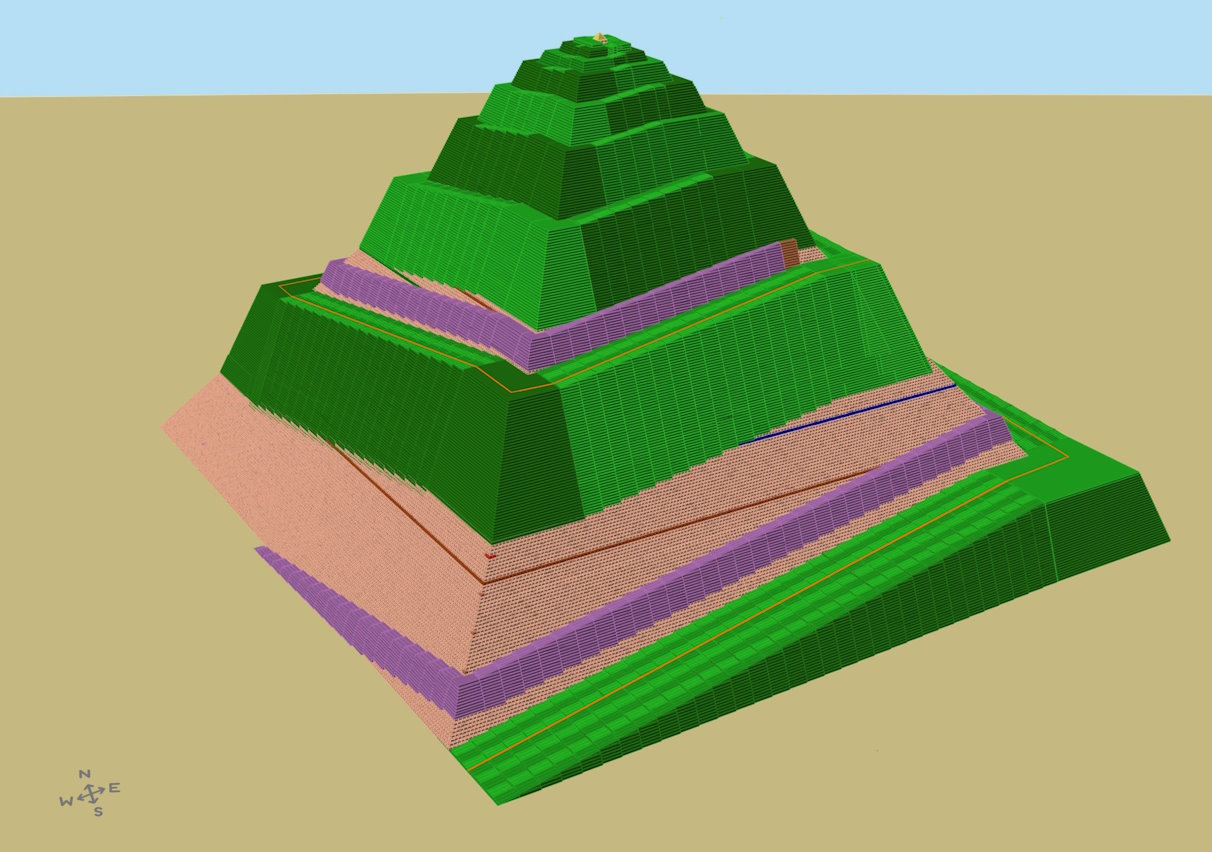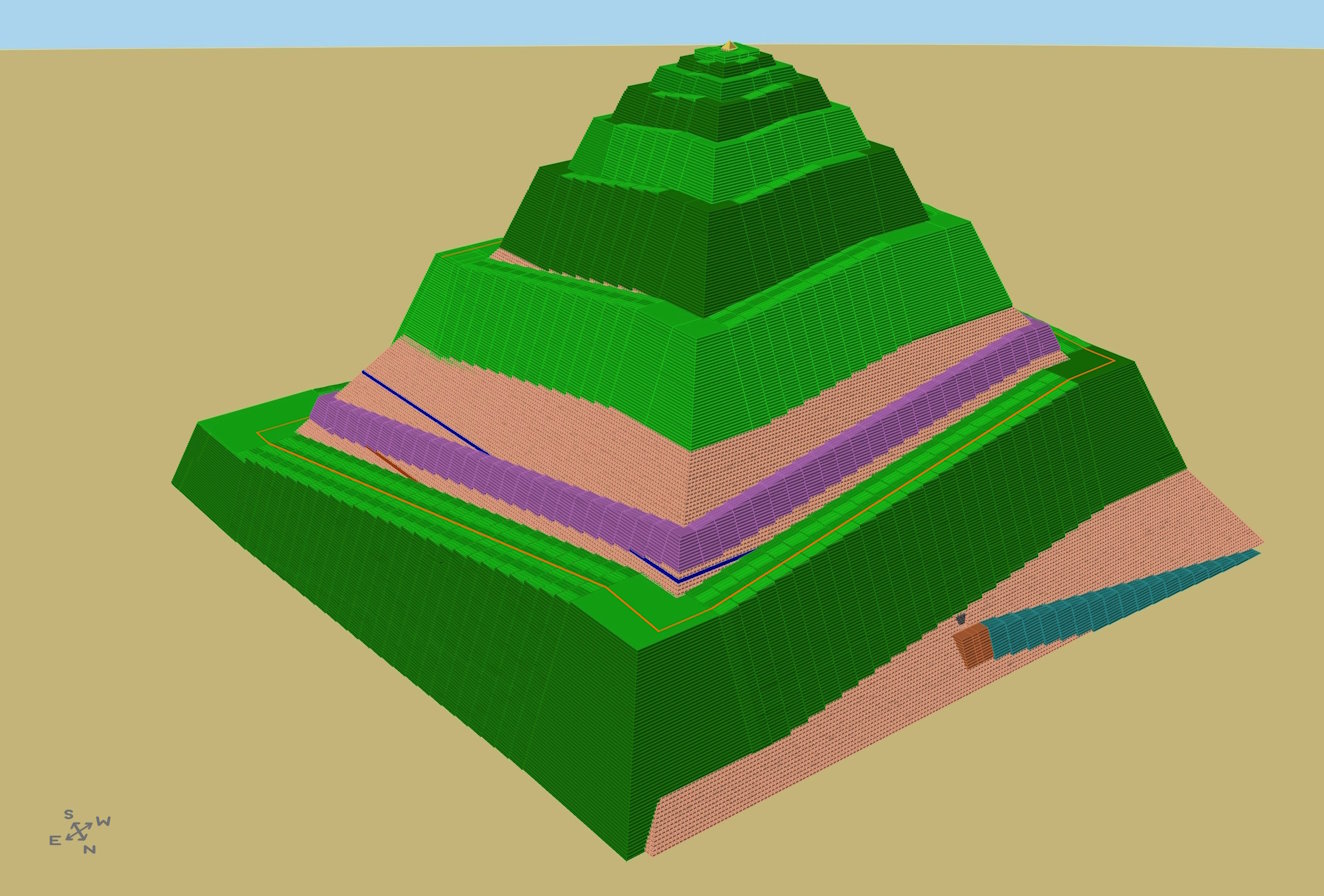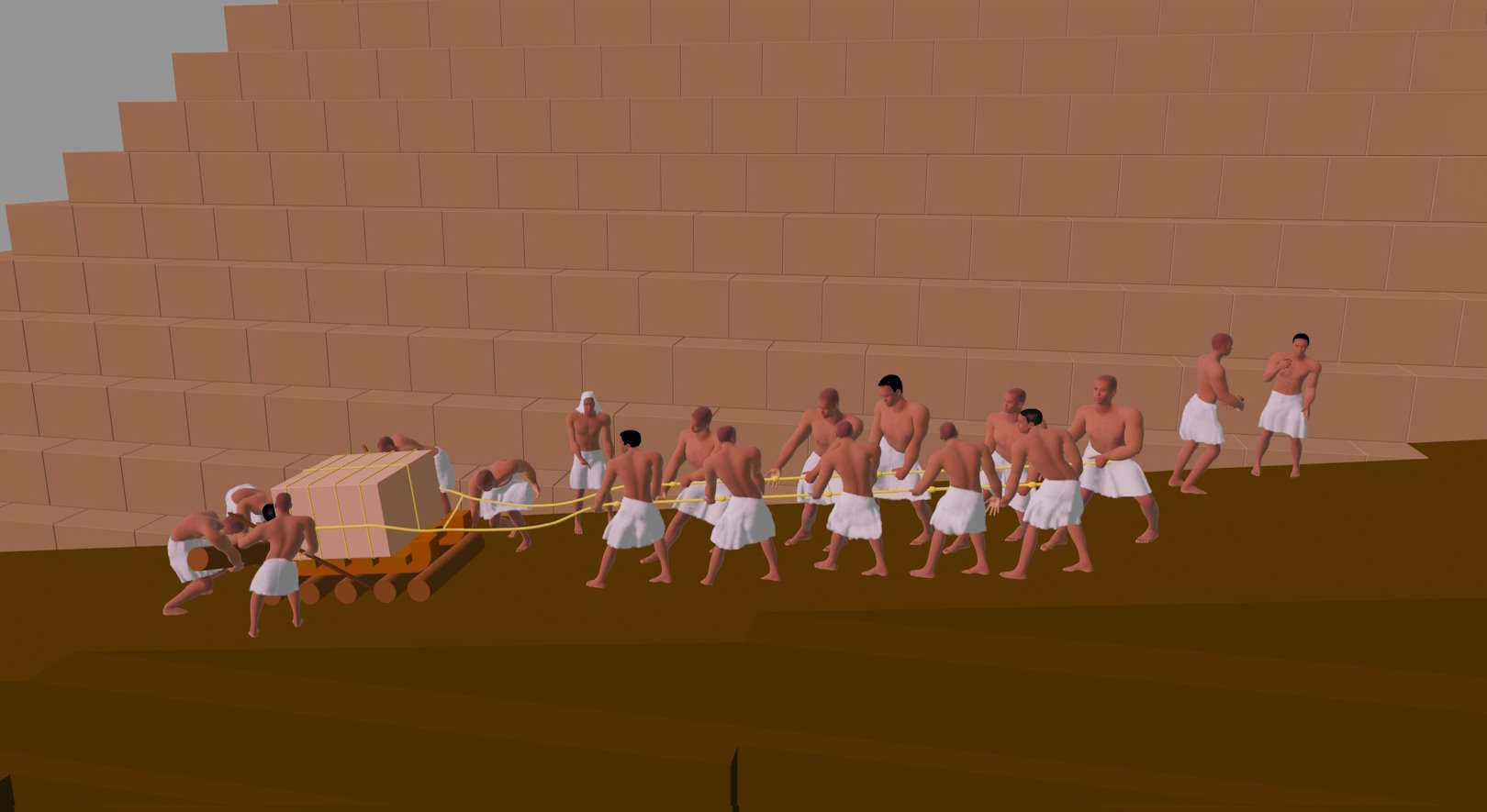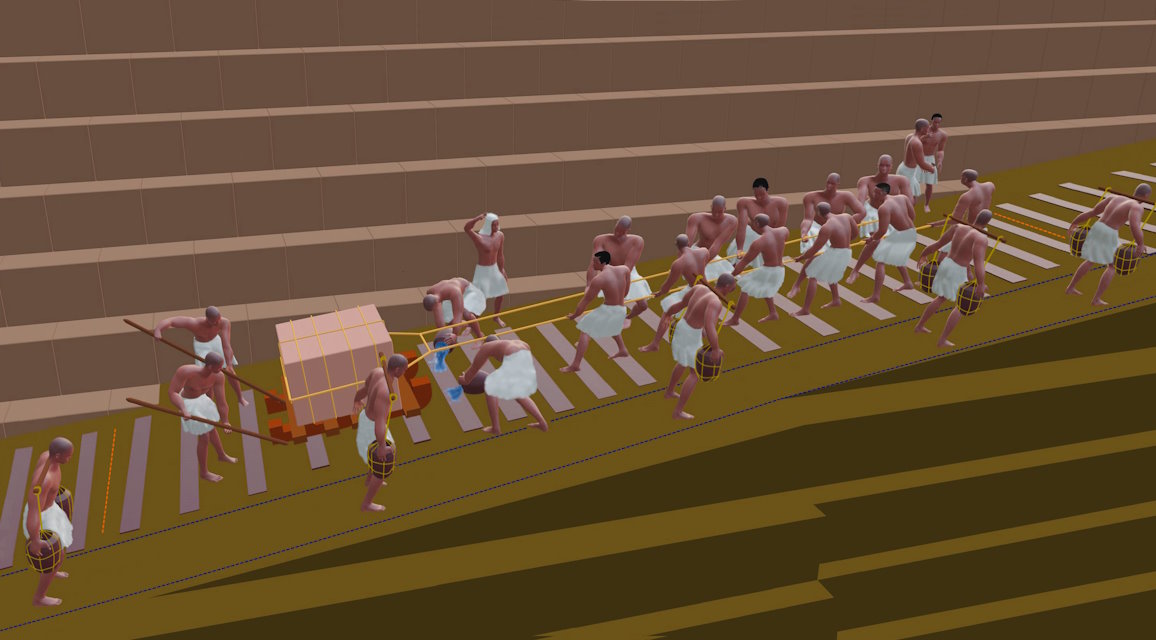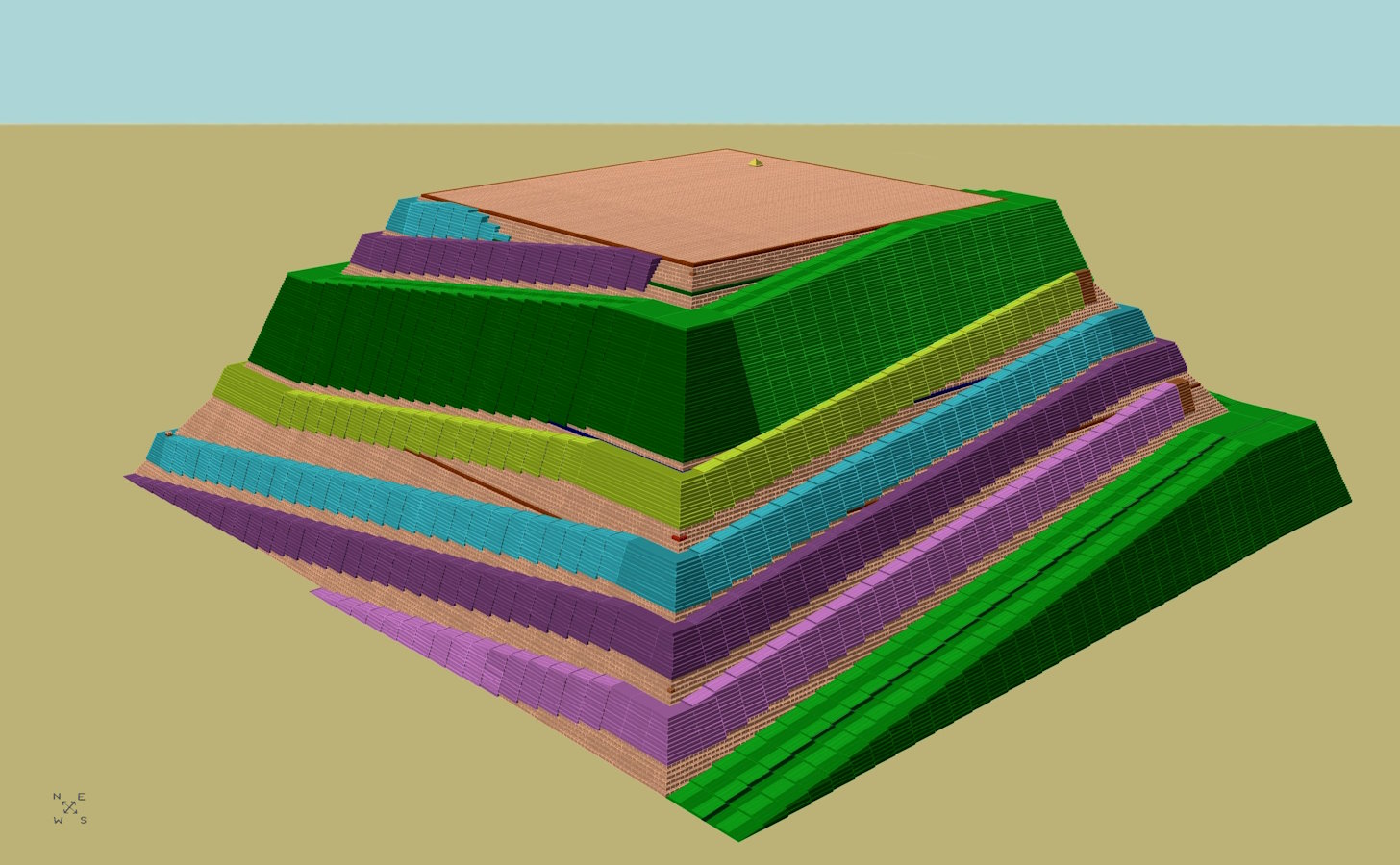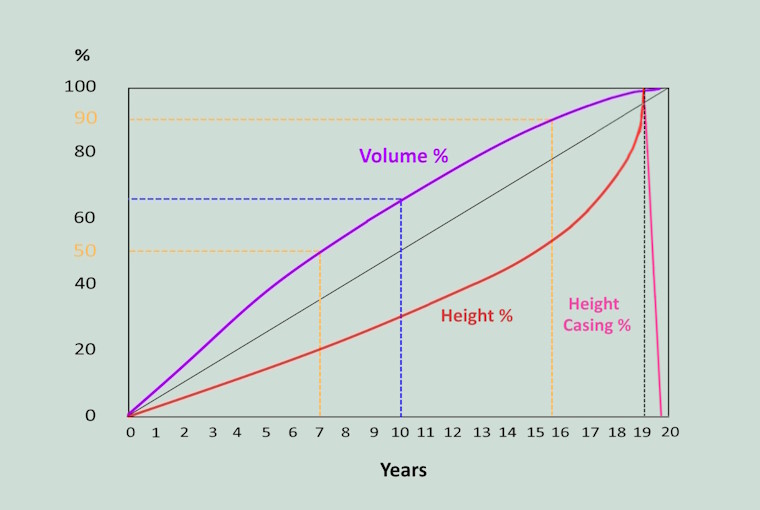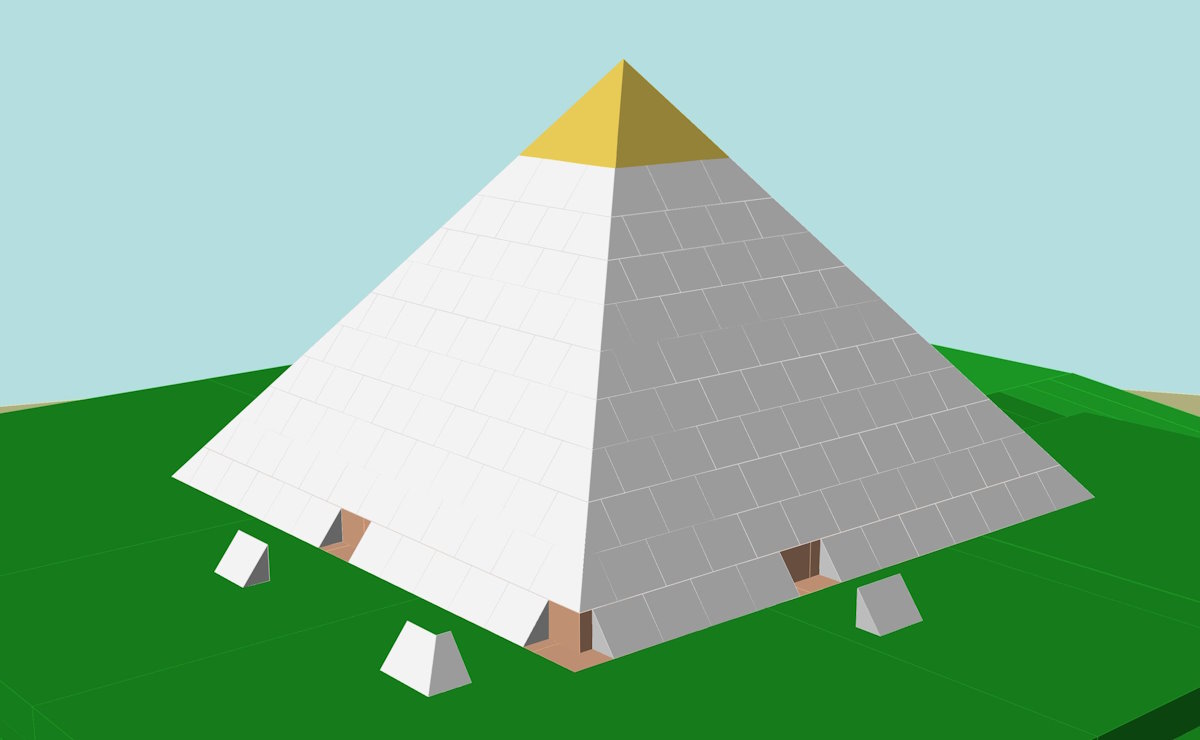
Constructing the Cheops Pyramid Through Multispiral Ramps
The Cheops Pyramid is the largest Egyptian pyramid and is therefore also known as the Great Pyramid. It was built around 2600 BC and is considered the tomb of the Pharaoh Cheops with the Egyptian name Khufu. The pyramid is the oldest of the Seven Wonders of the Ancient World and the only one to remain largely intact.
The image from Mozaik Education shows the Pyramids of Giza from 4500 years ago. There is also a 3D representation of this.
The casing out of white limestone made the pyramids appear like diamonds in the sunlight.
- Although the Great Pyramid is one of the most impressive structures of mankind, there are almost no documents or archaeological finds that indicate its construction technique.
- The pyramid builders belonged to a high guild, which probably kept their knowledge extremely to themselves. They made sure that all notes were destroyed.
- According to the two historians Herodotus and Diodorus, the construction time was only 20 years.
- How could the Egyptians in the Old Kingdom build this pyramid?
There are many theories about this. However, most of which are completely absurd and none of them can explain the construction completely and satisfactorily. Therefore, this problem is considered as a mystery of mankind. - The solution to the mystery can be expressed briefly:
Spiral ramps out of mud-bricks
and transport with wooden rollers.
At first this may seem sobering, as both elements have been discussed for over 100 years. The combination of efficient transport techniques and the arrangement of the ramp paths leads to a solution. See the sections „Multispiral Model“ and „Tow Team“. - The construction of the pyramid was the largest and most important project for the pharaoh to ensure his reputation in posterity.
This project would never have been started
without a clear and controllable technology. - The construction is consistent with the few archaeological finds and historical evidence. See the „Historical Evidence“ section.
- The task of future archaeologists will be to examine the outermost layer of the pyramid for ramp traces.
External Ramp
Using an external ramp seems to be the most immediate method. This ramp model was proposed by Ludwig Borchardt in 1928.
With an inclination angle of 6.6 degrees or 11.6 %, the ramp would have a length of 1.2 km and a volume of 135 % relative to the pyramid.
Since the two neighboring pyramids did not exist at that time, the ramp could have looked like demonstarted in the image. This is probably the only way to place an external ramp in this landscape.
- It would take more than 10 years to remove this ramp. Therefore, it is impossible to complete this monument within 20 years
- If this critical time limit would not exist, then the external ramp would have been considered as a possible solution to the problem for long. Therefore, other possibilities must be considered.
- The Sphinx probably already existed at this time and had an animal head that was larger than today’s. Sculptures as hybrid creatures only existed from around 1500 BC.
Seven Misfortunes
In 1799, the Rosetta Stone was found containing Egyptian hieroglyphs and ancient Greek texts. Within just three years, the physicist Thomas Young partially succeeded in deciphering the hieroglyphs, what was completed by Jean-François Champollion.
On the other hand, the mystery surrounding the construction of the Egyptian pyramids has not been solved in the last 200 years. What are the causes for this?
1) The ancient Egyptians left no written documents regarding the construction of the pyramids. This meant that historians had no way of solving the mystery.
2) After the pyramids were completed, the Giza Plateau was considered a representative location. Therefore, it is understandable that all building rubble was cleared away, depriving the archaeologists of their work base. In addition, plenty of mastabas for higher officials were placed next to the pyramids later on, so possible archaeological traces may have been removed.
3) There are some archaeological finds at earlier pyramids. However, these were smaller and different in structure. The construction method did always change. Only the previous construction, the Red Pyramid, was the first real pyramid.
4) The historian Herodotus reported in 450 BC that the pyramids were built by slaves. But he had his information from dubious sources.
Accordingly, his description of the stepped stairs was misinterpreted. This was supplemented by a description of lifting devices.
The picture by Antoine-Yves Goguet from 1758, which was probably recolored, represents the distorted view of history.
Such a block of stone weighs more than 15 tons and cannot possibly be transported in this way by 12 workers. In addition, the wooden beams of the lifting devices would not be able to withstand this load.
5) The Museum of Science in Boston developed a model for building the Pyramid of Menkaure in 1950.
The archaeologist Dows Dunham from Harvard University played a key role in this project. He received the gold medal from the Archaeological Institute of America in 1979.
Walter Vose from the Massachusetts Institute of Technology provided practical engineering advice on the project.
The artist Peter Jackson made this lithograph probably based on this project.
In 1956, Dows Dunham made a corresponding publication in the journal Archaeology.
This includes the recolored graphic, which shows how a spiral path starts on each of the 4 sides. That was a tremendous innovation at the time.
This ramp model is briefly mentioned in the books by Georges Goyon and Mark Lehner, it is stated to be interesting but unsuitable.
Ultimately, it is completely inexplicable why this pioneering work has received little attention from experts for 70 years and no one has tried to develop it further.
6) A possible explanation is that spiral ramps were discredited for three reasons and therefore, not considered a serious solution. Firstly, it was impossible to explain how the huge blocks were turned 90 degrees at the corners. Secondly, the spiral ramps were criticized for not having enough transport capacity in the lower and middle areas of the pyramid.
All other models were widely discussed. In particular, the models by Georges Goyon, Mark Lehner and Jean-Pierre Houdin received a lot of attention, although for each model there are several reasons why it is not a solution. One reason they have in common is that in the upper half of the pyramid they use one spiral path with only one transport lane without a separate way back. Thus, the construction time would be more than 30 years.
In the first two models, the outer casing is completely covered by the ramps. Therefore, measurements are hardly possible, which led to a third discredit.
7) Overall, the opinion among archaeologists has emerged that ramps are the most tenable method of lifting the blocks. However, this is an incomplete method that must be supplemented by another device. That’s why so-called combination models have been favored since 1980.
These are suggestions for completing the Four Spiral Model by Dows Dunham:
- The huge blocks don’t need to be turned at all, since they only take up a maximum of 2 % of the pyramid’s volume. See the „Huge Blocks“ section. This eliminates the first discredit of the spiral ramps.
- In the lower half of the pyramid, some ramps must have a lager width so that there is enough transport capacity. See section „Multispiral Model“. This eliminates the second discredit.
- When building on levels, measurements can be done at any time. The precise measurement is carried out in a top-down process when attaching the outer casing. See “Measurements and Precision” section. This eliminates the third discredit.
- Some ramps end at different heights since space becomes narrower at the top.
- Only one ramp with a width of at least 6 m leads to the top of the pyramid. This allows the pyramidion to be placed on top.
- This system of ramps has enough transport capacity in the middle and upper areas of the pyramid. See section „Construction Time“.
- The ramp material is made of dried mud-bricks. These are transported using the chain principle. See the „Ramp Construction“ section.
- Last but not least, the system needs a reasonable transport method. There may well be historical evidence for the method of sliding sledges on wooden beams, but this is completely unsuitable for the construction of the pyramid. A comparable method using sledges on rollers requires only half the towing team. See “Towing Team” section. In addition, the sliding sledge method requires an enormous number of water carriers and the barefoot workers would constantly slip on the wet Nile mud.
Conclusion:
The adapted model is not a combination model. None of the sublimentary devices are required, which are generally not suitable for mass transport. It is the optimization of a dynamic ramp system.
The construction of the Great Pyramid was the most important project in the state. This was always linked to the fight against time. If there had not been a clear and manageable technology, the project would never have been started. See the „Strategy“ section.
The following image shows the evolutionary lines of the ramp models. The dashed lines indicate that the corresponding models were created independently and without knowledge of the previous model by Dows Dunham, since it was almost not mentioned in the literature.
Uniform Pyramid
Then the inner step pyramid is decorated with an outer casing. The corner and deco stones of the casing are placed on the steps of the inner pyramid.
There is an additional level with a gold-plated keystone at the very top. This stone is a mini pyramid and is called pyramidion.
The Great Pyramid consists of 210 levels including the Pyramidion. As a uniform pyramid, the Great Pyramid would have 3 million blocks.
The lowest red line indicates the height at which half or 50 % of the material was installed. This process took 7 years and only a height of 20.5 % was reached at that point.
The blue line shows the height after half of the construction period or after 10 years. Two thirds of the material was installed at that point.
The green line stands for half of the height or the median. This construction phase was reached after three quarters of the construction time or 15 years.
Thus, for many years the Pharaoh saw only a truncated pyramid which did slowly grow.
Multispiral Model
The main green ramp starts from the south side which is close to the quarries. When starting at the bottom, this ramp has 6 transport lanes, after the first turn only 3 lanes.
The main ramp leads to the top of the pyramid. In the upper third of the pyramid, the ramp paths partially rest on the path below.
When transporting a block from the bottom to the top, a distance of 1.8 km is covered and 8 circuits are made. The transport takes 12 hours, which corresponds to almost 2 work shifts.
On the other 3 sides there start 2 ramps with only one transport lane.
These 6 single paths end at different heights. The ends are marked in red.
The entire model consists of 7 spiral paths.
The dark blue ramp ends at the north entrance which is marked in black. This was a restricted access area.
- The green main ramp has 6 lanes in the initial phase. After the first turn of the ramp after 5 years, the outer 3 lanes can be dismantled and the ramp material can be reused further up. This is dynamic ramp construction. The boundary line is marked in orange.
- The total ramp material has a volume of only 8 % of the volume of the pyramid. This is a huge advantage over the external ramp, which has a volume of 135 %.
- The many ramp paths make it possible to create a working platform at almost any location for the later application of the outer casing. See section „Outer Casing“.
Three-Spiral Model
The theory of spiral ramps allows for further variations.
In order to keep the delivery route from the quarries as short as possible, the entire delivery is made via the green main ramp.
In the initial phase, this ramp path has 8 transport lanes. After the first turn, there are 6 lanes and in the upper half of the pyramid there are only 3 lanes.
This model has a certain similarity to the single-spiral model by Georges Goyon.
- Due to the wider ramps, this model requires more ramp material. As the pyramid increases in height, the ramp material can be mined from the outside inwards up to the orange line and reused further up, reducing the ramp material from 15 % to 9 %.
- When building the inner step pyramid, a lot of ramp material had to be relocated.
- When installing the outer casing, a large part of the work platforms must be created. The blocks for the outer casing can only be delivered to one location and then have to be transported further on the work platform.
- Blocks weighing 50 tons can be transported on the wide ramp up to half the height of the pyramid.
- Wide ramps have less stability.
- Ultimately, it is difficult to decide which of the two models has the greater advantage. The three-spiral model has the advantage of being simpler and clearer and probably corresponded better to the habits of the time. A clear decision can only be made archaeologically by examining the remains of ramp material between the stone blocks.
Tow Team
A tow team of 18 workers is required to transport a 2.3 ton block.
At the command of the commander (4), ten workers (5) pull simultaneously for one second with a force of 35 kp. This moves the sledge with the block by 25 cm.
The two workers (6) on the right are enjoying the break.
The two workers (3) with the wooden bares ensure that the rollers remain parallel and do not jam.
After the towing process, the sledge stands for 4 seconds while the tow workers (5) reposition themselves.
The two workers (3) clamp the wooden bars between the rollers, what prevents the sledge from rolling back.
The worker (1) on the far left must always stand behind the sledge and catch the rollers. This prevents the rolls from falling off the pyramid, which is a massive risk of accidents.
The two workers (2) transport the rollers from back to front and reposition them.
- Within 5 seconds the team moves 25 cm, which corresponds to a speed of 3 m/min.
- The team has a space of movement of 12.1 m. This is marked with the orange lines.
- All teams must move at the same speed to avoid jams.
- The strain on workers over 6 hours with rotating breaks can be compared to today’s working conditions and corresponds in no way to slave conditions.
- The transport method requires that the surfaces of the ramps are kept smooth and stable at all times.
In the literature, there are almost exclusively presented a transport method in which sledges were pulled over wooden beams. The beams were constantly lubricated with Nile mud to reduce friction. See the picture above by Peter Jackson.
A towing team would consist of 18 workers and would be the same size as for transport with wooden rollers.
However, water carriers were required in addition when using Nile mud.
- The water carriers would have to deliver the Nile mud not only at the end of the delivery lane, but for all tow teams along the entire transport lane.
- When building the upper half of the pyramid, the routes are longer than 1 km and more than 50 teams would be on one transport lane. Therefore, the number of water carriers would increase considerably.
- The water carriers would require a separate walkway as they are large in number and would move at 8 times the speed of the towing teams. This way is marked by the two blue lines. Therefore, the ramps would need to be 20 % wider. This would increase the ramp volume and the number of workers required to build the ramps by 44 %.
- For example, let’s look at level 112, where 90 % of the volume was built up. At this point, 2,442 water carriers would be needed and only 6,586 workers would be available for towing, which is presented in Table 3. In comparison, if wooden rollers were used, 8,649 workers would be available for towing, which is shown in Table 1.
- In addition, the workers would have difficulty moving on the slippery transport paths.
- Under the same working conditions, it can be said that with this transport technique, the construction time would increase by 4.3 years and the total work by 24 %. The detailed values and comparison are shown in the appendix of Table 3.
- The greatest possible efficiency was required because the project was a fight against time.
Construction Time
The image shows level 112, where 90 % of the material has been installed.
The pyramidion was transported up to there from level to level. All the huge blocks had been installed by then.
The main green path leads to this level with 3 lanes. There are also the light blue and dark purple paths, each with one lane. So a total of 5 lanes lead to this level.
When subtracting one lane for the way back, there are still 4 lanes left for delivering the blocks.
- This level has a width of 210 – 112 = 98 block widths.
- Therefore it consists of 98 ⋅ 98 = 9,604 blocks.
- There can be 180 blocks delivered per day and per transport lane.
- A total of 720 blocks could be delivered with 4 transport lanes per day.
- Due to the length of the paths, this would require more than 20,000 workers. Therefore, a maximum of 589 blocks can be produced and delivered per day. This only applied during the 3 months of the Nile flood.
- In the remaining 9 months outside of the Nile flood, there were only 10,000 workers. Therefore, only 294 blocks could be delivered per day.
- This results in an annual average of 368 blocks per working day.
- Therefore, this level has a construction time of 9,604 / 368 = 26.1 working days.
- Since there were 300 working days per year, this corresponds to 0.09 years or about one month.
- The values for all 210 levels can be determined in this way. By adding the values for all levels results in the construction time of 19.1 years for the inner step pyramid, which is shown in Table 2.
- The outer casing requires only 0.7 % of the material and a construction time of 0.7 years.
- The total construction time is therefore 19.8 years.
- This model proves that the system of spiral ramps has sufficient transport capacity in the upper range of the pyramid. This is in contradiction to the literature. There are only models used that have only one transport lane in the upper two thirds of the pyramid without a separate way back. In this case the construction period would be at least 30 years.
- The transport problem can be completely solved with the described system of ramps. No further technology is necessary. This is contrary to the literature where it is mentioned that ramps require supplementary devices.
The diagram shows how the volume and height of the pyramid developed within the construction period of 20 years.
The blue dashed line indicates that after 10 years a height of 30 % was reached and the volume of 67 % was built. See the corresponding image in the „Uniform Pyramid“ section.
The black dashed line indicates that the height of 100 % was reached after 19.1 years when the pyramidion was placed.
Then the outer casing was installed from top to bottom in 0.7 years, so that the construction was completed after 19.8 years.
Huge Blocks
In the first 5 years, the huge blocks were brought onto the pyramid using the green ramp. That’s why they didn’t have to be transported on ramps around the corner. This saved the difficult turning at the corners.
The huge blocks were transported upwards from level to level. The temporary brown ramps with a slight slope of 2 degrees were used for this purpose.
The area on the pyramid was always so large that the huge blocks never required more than 15 % of the area.
Outer Casing
In January 2024, the Mitteldeutsche Zeitung published a newspaper article entitled Mystery of History Solved on this theory.
The idea, proof finding and implementation were developed by Dr. Rudolf Volz. He is a qualified mathematician, has developed software for many years and is interested in the central problems of humanity.
Sources: Image 1 and the background of Image 3 are courtesy of Mosaik Education.
Image 2 uses elements from 123rf.com.
Image 4 is by Gouchet and image 6 is by Dows Dunham.
Image 5 is by Peter Jackson, Bridgeman Images.
All other images are copyright of Dr. Rudolf Volz.
Imprint (2023 – 2024) – Deutsche Mediengesellschaft mbH – Auf den Steinen 2 – D-06485 Quedlinburg, Germany – info@cheops-pyramid.net
